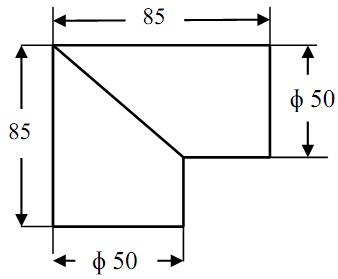Question 1:
a) A hexagonal pyramid side of base 35 mm and base 50 mm long rests with one of the edges of base on HP and its axis is inclined 30o to HP and parallel to the VP. Draw its projections.
b) A pentagonal prism side of base 20 mm and axis 60 mm long, lies with one of its longer edges on HP and its axis is parallel to both the HP and VP. Draw its projections.
Question 2:
a) A cone of base diameter of 50 mm and altitude 60 mm rests on its base on the HP. It is cut through a plane perpendicular to VP and parallel to one of its extreme generators, 10 mm away from it. Draw sectional top view and the true shape of the section.
b) A cube of side 40 mm is placed and cut through a plane in such a manner that its true shape of section is a regular hexagon. Draw the front and top views of the cube and find out the inclination of plane with the HP.
Question 3:
a) A square pyramid of base side 40 mm and axis 65 mm rests on its base on HP. A cutting plane inclined to HP and perpendicular to VP cuts the pyramid in such a manner that the true shape of section is a trapezium of parallel sides measuring 30 mm and 20 mm. Draw its sectional top view and the true shape of the section. As well find out the true inclination of the cutting plane to the HP.
b) A square prism of height 80 mm and a base of diagonal of 40 mm rest on HP so that its base edges uniformly inclined to VP. It is cut by a section plane passing via the mid-point of the axis of the prism perpendicular to VP and inclined to HP. Find out the inclination of the cutting plane if true shape of section is a rhombus of diagonals 60 mm and 40 mm.
Question 4:
a) Draw the development of a two piece elbow, illustrated below.

b) A vertical chimney of 70 cm diameter joins a roof sloping 35o to horizontal. The shortest part over the roof is 32 cm. Obtain the shape of sheet metal from which the chimney can be fabricated.
Question 5:
a) A cylinder of diameter 40 mm, height 70 mm is cut by a plane perpendicular to the VP and inclined at 55o to HP, meeting the axis at top face. Draw the lateral development of the solid.
b) A cone of base 50 mm diameter and height 60 mm rests with its base on HP. It is cut by a plane perpendicular to the VP parallel to one of the generators and passing via a point on the axis at a distance of 22 mm from the apex. Draw the sectional top view and develop the lateral surface the remaining part of the cone.